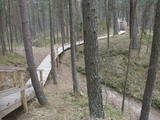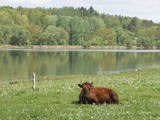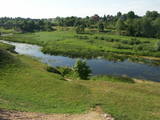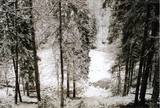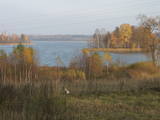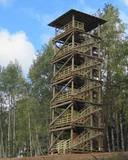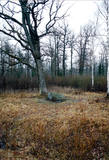| Nr | Name | Beschreibung |
|---|---|---|
|
Ap 9 km garā taka (vienā virzienā) sākas Skaņākalna dabas parkā (Mazsalacā) un beidzas pie Ramatas. Tā iepazīstina ar Salacas ielejas dabas parka nozīmīgākajām vērtībām – smilšakmens atsegumiem (Skaņaiskalns, Dauģēnu klintis u.c.), alām, nozīmīgu izmēru laukakmeņiem u.c. Taka marķēta. Tajā izvietoti informācijas stendi, norādes. Jāpadomā par loģistiku – kā nokļūt sākuma punktā. |
||
|
The mouth of the most beautiful river of Vidzeme. On the seashore between the mouths of River Gauja and River Daugava, one of the largest dune ranges in Latvia with distinctive parabolic dunes overgrown with forest (wooded dunes) is situated. The Mouth of River Gauja is unique as it is one of the few major rivers in Latvia and in EU countries to flow into the sea naturally. There is no harbour or other hydro-engineering construction. It is a popular recreation area in the vicinity of Riga and Saulkrasti while, unfortunately, the lack of infrastructure makes it suffer from anthropogenic load. Not far from the rivermouth, hidden in dunes, there are pillboxes which were built in 1920 or 30ies as anti-airborne barriers. There was a whole range of them along the coastline from the mouth of the River Lielupe to the mouth of the River Gauja forming a part of the Daugavgrīva Fortress fortifications. The pillbox is made of concrete, ca 1.5m thick. Every year, on the 3rd Sunday in August, a lamprey festival takes place in Carnikava town by the Gauja rivermouth. Carnikava is called the Lamprey Capital as it is famous for its lamprey fishing tradition and generous catches. The Mouth of the River Gauja is a good bird-watching area, especially in spring and autumn when one can observe the highest variety of species. Just few of the many bird species that can be observed near the Gauja rivermouth |
||
|
Der Naturpark im Ort von Jūrmala wurde eingerichtet, um die Dünen, den Kiefernwald und den Küstenlebensraum zu schützen. Der Park bietet einen der attraktivsten Naturpfade im Rigenser Gebiet. Er befindet sich in der Nähe der bekannten Ragakāpa-Düne, die teilweise bis zu 17 m hoch ist. Das ist eine ausgezeichnete Möglichkeit, den Dünenlebensraum und seine Pflanzen, Vögel, Insekten usw., die hier leben, zu schützen. Man kann auch Kiefern sehen, die 100 Jahre und älter sind.
|
||
|
The park was established to protect the Venta River valley and the landscapes that are around its tributaries. On the west bank of the Venta, at Papilė, there is a cliff from the Jurassic period which is unique in the Baltic States, has been known since 1925, and has layers in which more than 300 forms of life have been identified over the course of time.
|
||
|
Der Naturpark im Tal der Daugava ist der einzige Ort zwischen den Kaskaden der Wasserkraftwerke, wo man noch die Chance hat, das Flusstal der Daugava und die Schluchten der Nebenflüsse so zu sehen, wie sie waren, bevor das Gebiet geflutet und die Kraftwerke gebaut wurden. Einen besonders schönen Blick hat man vom rechten Flussufer in der Nähe von Kirche und Burgberg von Aizkraukle. Wälder, Wiesen, Flussquellen und kleine Dolomitfelsen sind in dieser Region alles geschützte Biotope. Freizeitangebote gibt es auf dem Burgberg von Aizkraukle, die Schloßruinen von Aizkraukle sind nicht weit entfernt.
|
||
|
The most important aspects of this park are a shallow lagoon-type lake – Lake Pape, with its flood land meadows, the shore of the Baltic Sea, the Nida swamp, and the more than 270 different types of birds that have been spotted here. The oldest bird ringing station in Latvia (est. 1966) is found between Lake Pape and the Baltic Sea. Birds and bats are caught and ringed there. Lake Pape is the first place in Latvia where so-called “wild” horses (the “Konik” breed) were released with the aim of managing the flood land meadows.
|
||
|
Der Bauska Naturpark verläuft für mehrere Dutzend Kilometer am Lielupe-Fluß und an seinen Nebenflüssen – der Mūsa und der Mēmele – entlang. Das ist ein geschütztes Territorium. Die Ufer dieser Flüsse enthalten einige der größten Dolomitklippen in Zemgale. Diese sind sowohl als Biotop als auch als geologisches Denkmal geschützt. Die Flüsse sind wichtige Laichplätze für Flussneunaugen und Zährten. Touristen werden von der Kulturlandschaft des Gebietes beeindruckt sein, genau wie von den Kulturdenkmälern wie z.B. vom Schloß Bauska, dem Park Jumpravmuiža, dem Mežotne - Burgberg und - Schloß, dem Vīna - Berg usw. Die Flüsse sind für Wassertourismus geeignet.
|
||
|
Ein mit Wäldern und Seen reiches Gebiet im Nordteil der Dzūkija-Anhöhe. Das Täufelsbeet (Velnio duobė) ist eine bis 40 m tiefe und 200 m breite trichterförmige Grube, die Entstehung der mit einer Tätigkeit eines urzeitlichen Gletschers verbunden ist. |
||
|
The Buse (Matkule) castle hill is near the Imula River. From the castle hill and from the opposite shore of the river, you can find one of the loveliest views of Kurzeme’s small rivers. Their appearance is best when trees and other flora are bare and the view is unimpeded. A wonderful view of the Imula valley is also seen on the road to the castle hill – near the Buse homestead.
|
||
|
This is one of the highest points among the hillocks of the Selonian area of Zemgale – Borīškalns Hill. From the tower, you will see Lake Sauka, as well as the forests and farmland which surround it. The “Kalna Ļūdāni” farm is nearby, and its owner uses his livestock to help to maintain the surrounding landscape.
|
||
|
Ārkārtīgi ainaviska teritorija Augšzemes augstienes centrālajā daļā ar vairākiem ezeriem - Medumu, Lielo un Mazo Ilgas, Šķirsteņu un dažām mazākām ūdenstilpēm. Medumu ezera salām ir dabas lieguma statuss. Teritoriju šķērso vairāki grantēti ceļi, no kuriem dažviet paveras brīnišķīgas, bet nelabiekārtotas skatu vietas. Teritorijā atrodas Medumu katoļu baznīca. Piemērota teritorija dažādu aktīvā tūrisma veidu attīstībai. Dabas parks ietilpst Augšzemes aizsargājamo ainavu apvidū. |
||
|
The “backbone” to this park is the valley of the Šventoji (Holy) River. One of the most impressive Devonian cliffs in Lithuania can be seen from the river – Vetygalos atodanga. On the shores of the Varius stream is a cliff made of quartz and sand – Variaus atodanga. 6 km to the S of Anykščiai is Lithuania’s second largest rock (5.7 m high, ~100 m3) – Puntukas akmuo.
|
||
|
This park is in a region of hillocks in the Karula highlands, and Lake Ähijärve is at its centre. The park offers a cultural environment of small farms, and it was set up to protect the unique cupola-shaped hillocks of the area. Main attractions: Scenic Lake Ähijärv (176ha), Rebasemõisa Tornimägi hill (137.8 m above sea level), undulating landscapes. |
||
|
Atrodas Numerenes dabas parka teritorijā. 20 m augstais tornis uzbūvēts uz t.s. Numerenes vaļņa, no kura paveras plaša ainava un aizaugošām lauksaimniecības zemēm un nelielu mitrāju ar Kugreņa ezeru austrumu virzienā. Torņa apkaimē izveidota izziņas taka. |
||
|
We recommend that you walk through the town of Kandava not only to enjoy the charm of a small town, but also to find fantastic viewing locations where you can see the town and the shores of the ancient Abava River valley from the Kurši (Ancestor) castle hill, Lielā Street, the Bruņinieki castle hill and Zīļu Street (School Hill), as well as from the area of the Ozolāji open-air stage.
|
||
|
This territory was established to protect the lovely central section of the Neries River, local species, and Lithuania’s largest oak forest.
|
||
|
Ein wichtiger Komplex an Küstenlinie und Sanddünen entlang der Mündungen der drei Flüsse – Lielupe, Daugava und Gauja. Diese Gegend hat sehr alte Traditionen für Erholung und Kurbetrieb. Das Gebiet hat eine wunderschöne Küstenlandschaft und weist eine der wenigen Küstenwiesen von Lettland auf. Der Park umfaßt auch einige geschützte Areale – die Wiesen der Lielupe – Mündung, Vakarbuļļi, Daugavgrīva, Vecdaugava und Ummis (siehe Abteilung “Geschützte Naturareale”). Interessante Naturelemente in dieser Gegend sind das Amphitheater der Garciems – Dünen, zusammen mit einzelnen Dünen wie der Legzdiņi – Düne und der sogenannten Skiberg – Düne. Besucher werden durch verschiedene Kulturdenkmäler angezogen - den Befestigungsanlagen auf der Mangali – Insel, Militärbauten aus der russischen Zarenzeit bis zum Ende der sowjetischen Okkupation, der Festung von Daugavgrīvak, dem Vecāķi Kurbad mit seinen alten Küstenbauten und den Stränden von Daugavgrīva und Vecāķi. Die Nähe zur Stadt Riga und die verschiedenen wichtigen Erholungseinrichtungen sind der Grund für die vielen Erholungssuchenden in diesem Gebiet. Der Naturpark ist für aktiven Tourismus geeignet (wandern, Rad und Boot fahren, Autosport), Langlaufski, Natur- und Vogelbeobachtung, Kulturtourismus, passiver Freizeit- und Bildungstourismus. Es gibt Naturpfade in den Daugavgrīva- und den Rožu-Dünen zusammen mit anderen Einrichtungen der Infrastruktur.
|
||
|
This park was established to protect Lithuania’s longest lake, Lake Asveja (> 20 km). The lake is in a sub-glacial valley carved out by ice during the Ice Age, and it actually resembles a wide and curvy river.
|
||
|
Latvia’s highest hill is the second highest in the Baltic States, but alas, it has only a wrecked viewing tower, so you’ll have to look for the best views on your own. You’ll find some around the tower and the ski trails, particularly Large and Small Golgotha. It is worth hiking the Gaiziņkalns nature trail.
|
||
|
The Mežotne castle hill is on the left bank of the Lielupe River and opposite the Mežotne Castle. This was one of the largest Semigalian fortified castle hills during the 9th to the 13th century, and an ancient town alongside the hill covered 13 ha of land. The castle hill has been improved. A pontoon bridge across the Lielupe allows hikers and bikers to reach the castle (between May and October). Vīna Hill is approximately 500 m to the South of the castle hill, and a wooden pathway leads to it. |
||



